List of the directors of the Antikensammlung Berlin
The list of directors of the Antikensammlung Berlin is a list of the directors that the existing in Berlin since 1830 Antikensammlung Berlin and its predecessor, the cabinet of antiquities have passed from 1686 to 1717.
Historical summary
In 1686, Lorenz Beger , who brought a large part of the collection from Heidelberg to Berlin as royal inheritance, was given its own director for the first time in 1686 . Previously, the antique pieces were housed with the others in the court collection and administered by a joint manager. Beger's nephew Johann Carl Schott became his successor. During his time in office, Friedrich I, a king, died who paid a lot of attention to the collection and greatly expanded it through purchases. His son, the soldier king Friedrich Wilhelm I , had no significant interest in the collection. After Schott's death, the collection was given up again and a large part of the collection was lost through donations and sales. Art and other objects were also collected afterwards and collected in the "art chamber", which was headed by an administrator. In 1798 the management of this collection was transferred to the Academy of Sciences, between 1810 and 1811, i.e. in the course of the foundation, the "Naturalia" collections were transferred to the care of the new university . Like the art collection, they were no longer subject to the academy since 1809.
With the restructuring of the sciences in Berlin under reformers such as Wilhelm von Humboldt and increased collection activity in the course of classicism , a restructuring of the museum landscape in Berlin was also discussed in the first third of the 19th century. In the course of this, the public collections for sculptures and casts were founded in 1830 under the direction of the sculptor Christian Friedrich Tieck . The cabaret (coins, vases, terracottas, cut stones, etc.) found acceptance in the Antiquarium , whose first director Konrad Levezow was. Since Alexander Conzes was appointed in 1877, only archaeologists have been directors of the collections. With the death of Ernst Curtius , the Antiquarium and the Sculpture Collection were merged after a long period of planning under the direction of Reinhard Kekulé von Stradonitz , who was previously only responsible for the Sculpture Collection .
With Carl Weickert , who headed the collection in the difficult years between 1936 and 1947, the unity of the Berlin collection initially ended. As early as the beginning of the war, the museums - most of the antiquities collection was located in the Altes Museum , the architecture halls were housed in the Pergamon Museum - were closed, the large architectural parts were secured and most of the cabaret was outsourced. After the war, many of the items in Berlin were brought to the Soviet Union as looted art . Under the direction of Carl Blümel , the museum was redesigned and opened to the public in 1958/59 after the repatriation of a large part of these pieces. In West Berlin , the collection was redesigned from 1958 under the direction of Adolf Greifenhagen , mainly with items from the transfer to western Germany and reopened in 1960 in the western Stüler building . With the German reunification , the two Berlin collections of antiquities were merged in 1993 under the direction of the West Berlin collection by Wolf-Dieter Heilmeyer and have been presented together again on Museum Island since 1998 .
During the time of the great excavations of the museum, especially between the 1880s and 1910s, Carl Humann and Theodor Wiegand, two foreign directors (also department heads ) with extensive powers, were stationed in the Ottoman Empire , who were responsible for all excavations in Asia Minor and in some cases beyond were responsible.
The directors of the Antikensammlung are responsible for the structural, personnel and financial management of the collection.
Directors
The table can be sorted alphabetically or chronologically in the columns Name , Position and the year categories. Sorting is specified according to the year of entry into the director's position. If the starting years are the same, the person with the longer stay in the museum is classified first.
- Name : the name of the collection manager, sortable by surname. In addition, the life data are given to help with classification.
- Position : Details of the exact collection, but no exact contemporary names, which may vary
- from : beginning of the management time
- until : end of management time
- Comments : Comments on the biography and the relationship of the person to the Berlin collection
- Image : Portrait of the person, if there is a picture under free license
| Surname | position | from | to | Remarks | image |
|---|---|---|---|---|---|
|
Lorenz Beger (1653–1705) |
Head of the Cabinet of Antiquities | 1686 | 1705 | Initially, Beger was court librarian in Heidelberg from 1675 and administrator of the collection of gems and coins. In 1686, with the transfer of ownership of the Heidelberg art collection, he moved to Berlin, where he became an antiquarian and librarian. Under his aegis, the Berlin antiquities cabinet was systematically expanded. From 1696 to 1701 he wrote the Thesaurus Brandenburgicus selectus , the most important archaeological text written by a German researcher before Winckelmann . Beger was best known for mythological studies; he put together various monuments from a mythological and iconographic point of view. |
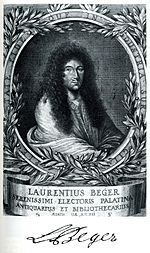
|
|
Johann Carl Schott (1672-1717) |
Head of the Cabinet of Antiquities | 1705 | 1717 | Schott was Beger's nephew and already worked as a draftsman and assistant on his thesaurus project. He succeeded his uncle as head of the cabinet of antiquities. With the description of the Royal Prussian. Antiques and Medals cabinet (I. Gemach) existing histor. He presented the first catalog of the Berlin collection in this form and in German for research into ancient history . He was one of the first to organize the artifacts according to subject groups instead of materials and asked archaeological questions at an early stage. | |
|
Jean Henry (1761-1831) |
Director of the Royal Chamber of Antiquities, Coins and Art | 1794 | 1805 | Henry comes from a Huguenot family and was trained as a preacher. In addition to this position in the Huguenot community, he also became royal librarian (first third, second librarian in 1795), who traditionally also headed the Kunstkammer in the Berlin Palace . During Henry's tenure, the collection was massively increased, and the collection came under the jurisdiction of the Prussian Academy. The various areas of the rapidly growing collection are subordinated to professionally experienced staff, the antiques and coins, for example, to the archaeologist Aloys Hirt together with the grammar school director Johann Heinrich Ludwig Meierotto . In 1798 and 1801 many of the original antiques from Potsdam were added to the collection. In 1805 he published the guide general directory of the Royal Art, Natural History and Antiques Museum and also pushed for a new museum building for the collection, which was bursting at the seams, in its few rooms, which also contradicted modern communication concepts. Henry advocated an open concept of a public museum as well as a universal museum and, on the first question, opposed the academy, which preferred a scientific collection with limited access. Many of his concepts were later implemented with the Altes Museum am Lustgarten. In 1806 he fled to Memel with his family and large holdings of the coin and gem collection . In 1815 he brought some of the antiquities that Napoleon had kidnapped to Paris back to Berlin. On May 4, 1816, he was released as director of the Kunstkammer and the antiquities collection and at the same time released from his duties as a librarian. He mainly devoted himself to the antiquities and the coin collection. With the completion of the Altes Museum, Henry retired in 1830; Konrad Levezow was his successor. |

|
|
Konrad Levezow (1770-1835) |
Director of the Antiquarian Shop | 1826 | 1835 | Levezow was a student of Friedrich August Wolf and Christian Gottlob Heynes . From 1795 to 1824 he was a teacher at the Friedrich-Wilhelms-Gymnasium , in 1802 he also became professor of antiquity and mythology at the Berlin Academy of Fine Arts and Mechanical Sciences . In 1821 he became Jean Henry's assistant at the Art, Antiques and Coin Chamber, in 1826 head of the art cabinet, 1829/30 provisional director and 1830 director of the antiquarian shop. He transferred all antique coins, medals, cut stones and works of antique cabaret from the Kunstkammer to the Antiquarium. Levezow wrote a catalog for the exhibition and was a member of the Royal Academy of Sciences in Berlin. |
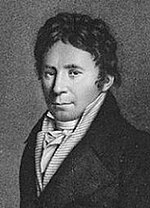
|
|
Christian Friedrich Tieck (1776-1851) |
Director of the Sculpture and Plaster Cast Collection | 1830 | 1851 | Tieck was one of the most prominent German sculptors and most prominent representatives of the Berlin school of sculpture in the 19th century. He was supported by Wilhelm von Humboldt and Johann Gottfried Schadow and spent a long time on study trips abroad. In 1819 he became Christian Daniel Rauch's studio partner and worked with him as well as with Karl Friedrich Schinkel . In 1820 he became a professor at the art academy , was vice director from 1839 and director of the academy from 1846. In the tradition of the 18th century, Tieck, a sculptor, was appointed to head the sculpture collection in 1830. Tiecks museum work suffered from the multiple workloads, and he could not show any special museum or archaeological achievements. |
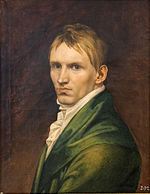
|
|
Ernst Heinrich Toelken (1785–1864) |
Director of the Antiquarian Shop | 1836 | 1864 | Toelken was educated in Göttingen, doctorate in 1811, habilitation in 1812. In 1814, after failure of a further career step in Göttingen, he became a private lecturer at the still young Berlin university and a high school professor at Friedrichwerdersche and later at the Köllnisches Gymnasium. 1814 another habilitation in Berlin. 1816 Associate Professor and 1823 Full Professor of Art History and Archeology, 1827 Secretary of the Academy of Arts. In 1815 he made an inventory of the looted art returned from France and was then a member of the commission that was supposed to collect the works of art for the new museum in various locations. In 1832 Toelken switched to museum work as assistant director under Konrad Levezow, but at the same time kept his professorship. In 1836 he became director of the antiquarian shop, which he headed for 28 years. He shared Eduard Gerhard's view of archeology as a historical science, as "monumental philology". He made a particular contribution to the processing of the gem collection. | |
|
Theodor Panofka (1800-1858) |
Director of the Sculpture and Plaster Cast Collection | 1851 | 1855 | Panofka studied in Berlin (1822 doctorate, 1827 habilitation), followed by a stay in Rome of several years. Here he met his long-time friend Eduard Gerhard, with whom many courses of life and research areas were similar, although Panofka was always something in Gerhard's shadow and could never achieve its after-effects. With Gerhard and others he belonged to the Roman Hyperboreans and later to the founders of the Istituto di Corrispondenza Archeologica , which later became the German Archaeological Institute . In 1826 he lived in Rome, then until 1830 in Naples, where he worked on the vase collection in the National Museum . From 1830 to the July Revolution of 1834 he was tutor in Paris in the household of the President of the Istituto di Corrispondenza Archeologica , Pierre-Louis de Blacas d'Aulps , and foreign secretary of the French section of the Istituto . In 1836 Panofka became an assistant at the Berlin museums, and from 1851 to 1855 director of the sculpture collection. In 1856 he was "downgraded" to curator of the Royal Vase Collection after a post had to be created for Gerhard. Panofka mainly worked on the vases and terracottas, and when assessing mainly mythological scenes that particularly interested him, often exaggerated interpretations. With Gerhard founder of the Archäologische Zeitung , 1836 member of the Prussian Academy of Sciences, 1844 associate professor at the university. |
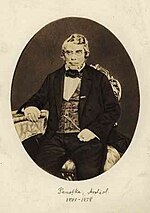
|
|
Eduard Gerhard (1795–1867) |
Director of the Sculpture and Plaster Cast Collection | 1855 | 1867 | Two longer stays took Gerhard to Italy from 1820 to 1832, where he devoted himself intensively to the study of antiquity. In 1829 he was the driving force behind the founding of the Istituto di Corrispondenza Archeologica , which later became the German Archaeological Institute . From 1833 he was employed at the Berlin Collection of Antiquities. In 1835 he became a reading academician , a year later curator of the sculpture collection, and in 1855 its director. In 1841 he founded the Archaeological Society of Berlin , in 1843 he became associate professor and in 1844 full professor of archeology at Berlin University . If Winckelmann is regarded as the founder of archeology as a science, Gerhard is regarded as the founder of archeology in detachment from philology as an independent science. He tried to collect and compile the ancient finds, but interpreted them less from an aesthetic than from a historical point of view. The antique collection owes much to Gerhard, including a better inventory and the collection of plaster casts that was made public in 1856. |

|
|
Karl Bötticher (1806-1889) |
Director of the Sculpture and Plaster Cast Collection | 1868 | 1876 | At the instigation of his father, Boetticher initially took up a practical construction profession and studied mathematics in Erfurt and then at the Bauakademie in Berlin. After graduating, he was initially a freelance contract draftsman. In 1839 he became a teacher of freehand and ornament drawing at the art academy for 36 years, and since 1844 he taught the subject as a professor. From 1854 to 1862 he also taught at Berlin University. In 1855 he also became an assistant at the sculpture collection, of which he became director in 1868. His term of office was marked by conflicts and wrong decisions. He dedicated himself in particular to the casts, which he considered to be didactically more valuable than the originals that happened to be available. His systematic reorganization of the statues was later rejected, and mistakes were made in preserving the statues under his leadership. After Boetticher, only trained archaeologists were appointed director. |
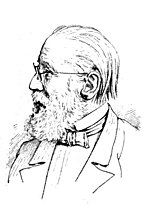
|
|
Carl Friederichs (1831–1871) |
Director of the Antiquarian Shop | 1868 | 1871 | After training and a short period as a teacher, Eduard brought Gerhard Friederichs to the Antikensammlung, where he compiled a catalog of Berlin antiquities within a year. In 1855 he completed his habilitation in Göttingen and came back to the Antikensammlung in Berlin in 1858, where he became the director's assistant in place of Theodor Panofka . In 1859 he also became an associate professor at Berlin University, in 1868 director of the antiquarian bookshop, and in 1869/70 he was out and about in the Mediterranean region on behalf of the Berlin museums to buy antiques. During his brief period in office, Friederichs made particular contributions to the publication of ancient works. |
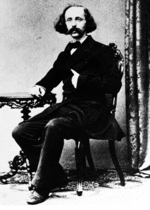
|
|
Ernst Curtius (1814-1896) |
Director of the Antiquarian Shop | 1872 | 1896 | Curtius came from a family that had produced some well-known people. His teacher in Göttingen, Karl Otfried Müller , was influential . Curtius was present when he died on a trip to Greece. After various positions in 1844 he became tutor of the future King Friedrich III. and also became Associate Professor at the University of Berlin. With his “Olympic speech” in 1852 he initiated the German excavations in Olympia and thus the major excavation companies in Germany in general. From 1855 to 1867 he was a professor in Göttingen, and from 1868 he succeeded Gerhard's full professor in Berlin. In 1872 he also became director of the antiquarian bookshop. On Curtius' initiative, the previously privately run Archaeological Institute became the Reich Institute in 1874. A year later, excavations began in Olympia, which Curtius directed until 1881. From 1871 to 1893 he was secretary of the philosophy-historical class at the academy. After Curtius' death, the Antiquarium was merged with the sculpture collection. |

|
|
Alexander Conze (1831-1914) |
Director of the Sculpture and Plaster Cast Collection | 1877 | 1889 | Conze was a student of Eduard Gerhard. In 1861 he completed his habilitation in Göttingen and became a private lecturer there . Two years later he went to the University of Halle as an associate professor , and in 1869 he became the first full professor at the University of Vienna . In 1877 he became director of the Berlin Collection of Antiquities. From 1878 he and Carl Humann devoted himself to researching Pergamon , but also Samothrace , and from 1887 to 1905 he was Secretary General of the German Archaeological Institute. |

|
|
Carl Humann (1839-1896) |
Foreign Director (Head of Department) | 1884 | 1896 | Humann first trained as a railway engineer and then studied at the building academy. From 1861 he lived in Constantinople, worked as a cartographer for the Ottoman government and built roads in Asia Minor from 1867 to 1873. In 1864 he was in Pergamon for the first time and promoted an excavation in Germany. But it was not until 1878 that he had a strong advocate in Alexander Conze, and in three excavation campaigns until 1886, excavations were carried out in Pergamon under the direction of Humann. Sensational finds like those of the friezes of the Pergamon Altar made Humann famous in Germany. Further recordings and excavations followed, for example, in Angora in 1882 (initiated by Theodor Mommsen and financed by the Prussian Academy) and in Zincirli (on behalf of the German Orient Society ). In 1884 Humann was appointed foreign director of the museums based in Smyrna and was thus responsible for all German activities in the oriental region. He could only initiate the excavations in Priene . |

|
|
Reinhard Kekulé von Stradonitz (1839–1911) |
Director of the Sculpture and Plaster Cast Collection | 1889 | 1896 | Kekulé was a student of Carl Friederichs. He looked after the almost blind Eduard Gerhard in the last years of his life and was thus associated with the Berlin Collection of Antiquities from an early age. From 1863 to 1868 he spent several years in the Mediterranean , especially in Rome , where he was strongly influenced by Heinrich Brunn's views . He completed his habilitation in 1868 at the University of Bonn , and in 1873 he became professor and head of the university's cast collection. In 1889, at the express request of Wilhelm II, he became director of the sculpture collection and was also made an honorary professor at the university, and a year later a full professor of archeology. After the death of Ernst Curtius, the long planned amalgamation of the sculpture collection and antiquarium took place under the direction of Kekulé. He was one of the main representatives of the purely aesthetically oriented Classical Archeology, which was primarily dedicated to the artistic-formal aspect of ancient art, but rather neglected the content and statements of the works. |
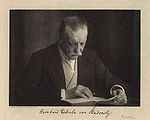
|
| Director of the Department of Antiquities | 1896 | 1911 | |||
|
Theodor Wiegand (1864–1936) |
Foreign Director (Head of Department) | 1897 | 1911 | Wiegand completed his studies in Freiburg with Franz Studniczka with a doctorate and was then a travel scholarship from the DAI . As such he came to Priene in 1894 , where he assisted the head of the excavations, Carl Humann . After he fell ill and died, Wiegand took over the management of the excavation. By 1897 he exposed the city completely. In 1897 he also became Head of Department (Foreign Director) of the Berlin museums in Turkey, his seat in Constantinople . Further excavations in Miletus and Didyma followed until 1911. In 1911 he became director of the antiquities department in Berlin and remained in the position until 1931. He then went back to Asia Minor to initiate a third phase of excavation in Pergamon. From 1932 until his death he was President of the DAI, which today has its headquarters in Wiegand's former home ( Wiegand House ). |
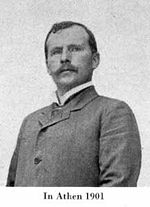
|
| Director of the Department of Antiquities | 1911 | 1931 | |||
|
Robert Zahn (1870–1945) |
Director of the Department of Antiquities | 1931 | 1936 | Zahn received his doctorate in Göttingen and then traveled to the Mediterranean region as a DAI travel scholarship holder. After his return in 1899 he became a freelancer for the Berlin Collection of Antiquities. In 1901 he became a permanent assistant director, in 1909 curator and after the death of Hermann Winnefeld in 1918, second director. In 1928 Zahn became an honorary professor at the university, and in 1931 director of the collection of antiquities. He remained in this position until 1936. Zahn was an internationally recognized specialist in antique ceramics, antique glass and antique gold jewelry. | |
|
Carl Weickert (1885–1975) |
Director of the Department of Antiquities | 1936 | 1947 | After studying in Munich, working at the Rome department of the DAI and participating in the war, Weickert became a curator at the Museum for Casts of Classical Art in Munich in 1919 . In 1929 he completed his habilitation at the University of Munich and became a private lecturer, and in 1933 an associate professor. A year later he became director of the Staatliche Antikensammlungen in Munich, and in 1936 director of the Berlin Antikensammlung. In 1946 he also became a professor at Humboldt University. In 1947, Weickert stopped working at the antiquities collection, which had been destroyed and relocated during the war, and at the university and became president of the German Archaeological Institute. | |
|
Carl Blümel (1893–1976) |
Director of the Antikensammlung Ost | 1947 | 1961 | Blümel studied in Berlin and received a travel grant from the DAI in 1924/25. In 1927 he became a research assistant and in 1929 curator of the Berlin collection. In 1935 he was appointed professor at the State Museums. After Carl Weickert moved to the head of the DAI, Blümel was appointed the new director. He was now in charge of the difficult reconstruction. Especially after the looted art was returned in 1958/59, he presented a concept for a new installation. Blümel was able to contribute his knowledge and skills as a trained sculptor to his archaeological work. | |
|
Adolf Greifenhagen (1905–1989) |
Director of the Antique Collection West | 1958 | 1970 | Greifenhagen studied in Königsberg and was then a DAI travel grantee. Then he built up the photo library of the Rome department of the DAI with Ludwig Curtius and Hermine Speier . After returning to Germany, he worked as an assistant in Bonn and Königsberg before taking care of the German volumes of the Corpus Vasorum Antiquorum from 1937 . From 1939 he did military service and was a Soviet prisoner of war until 1955. In 1957/58 he became custodian (head) of the Kassel Antikensammlung, but after a month he switched to the Berlin Antikensammlung, where he stayed until his retirement in 1970. During his tenure, the West Collection was rebuilt and the museum opened in 1960 in the western Stüler building . He was also acting director of the Egyptian Museum Berlin from 1958 to 1962 . Greifenhagen was a member of several academic academies as well as honorary professor at the University of Fine Arts and the Free University of Berlin. | |
|
Elisabeth Rohde (1915-2013) |
Director of the Antikensammlung Ost | 1962 | 1982 | Rohde received his doctorate in March 1945 under Gerhart Rodenwaldt at Berlin University. Immediately afterwards, she began working as an unskilled worker at the Berlin Collection of Antiquities. The took part in the protection of the antiquities in the last weeks of the Nazi regime and then participated in the reconstruction of the collection. In 1953 she was appointed custodian. Rohde assisted her predecessor Blümel in the redesign and reorganization of the collection after the war, especially after the return of the antiques brought to Russia in 1958. After Blümel retired in 1961, she was initially acting head of the collection in 1961 and then director of the collection in 1971. She had a special role in this respect because she lived in the western part of Berlin and was therefore not a GDR citizen. She stayed with the Antikensammlung in East Berlin, because she could hardly have made such a career in West Germany at the time. Rohde devoted himself in particular to research on the Pergamon Altar, Hellenistic architecture and Greek cabaret and ceramics. | |
|
Klaus Vierneisel (* 1929) |
Director of the Antique Collection West | 1971 | 1978 | Vierneisel studied in Munich and then received a DAI travel grant. He then worked for the Athens Department of the DAI and the Munich Collection of Antiquities. From there he was appointed to the management of the Berlin Collection of Antiquities, which he left in 1978 in favor of the then more important Munich collection. He stayed in this position until he retired in 1999. | |
|
Wolf-Dieter Heilmeyer (* 1939) |
Director of the Antique Collection West | 1978 | 1992 | After completing his doctorate in Frankfurt in 1965, he worked briefly at the Rome department of the DAI, received a travel grant and then worked on the Olympic excavation. From 1971 to 1977 Heilmeyer taught at the University of Tübingen before becoming a professor at the Free University of Berlin in 1977 . In December 1978 he also became director of the West Berlin Collection of Antiquities , and in 1985 also deputy general director of the State Museums. He designed several large special exhibitions. From 1993 he was director of the reunited collection and played a key role in bringing together the East and West Berlin collections on Berlin's Museum Island . The conception of the display of the Greek antiquities in the Altes Museum was particularly important . At the end of 2002 he retired. | |
| Director of the Reunified Collection of Antiquities | 1993 | 2002 | |||
|
Max Kunze (* 1944) |
Director of the Antikensammlung Ost | 1982 | 1991 | After studying in Berlin, Kunze became director of the Winckelmann Museum in Stendal in 1969 . In 1982 he became director of the collection of antiquities in the Pergamon Museum. In its early days, the permanent exhibition was redesigned and reorganized in a more contemporary way. Since 1990 he has been President of the Winckelmann Society , of which he had been managing director since 1971. In 1992 Wolf-Dieter Heilmeyer became director of the reunited collection of antiquities, Kunze deputy director. He surprisingly resigned from the position in 1993 and now devoted himself to the Winckelmann Society, completed his habilitation in Mannheim in 1996 and became honorary professor there in 2001. | |
|
Andreas Scholl (* 1959) |
Director of the Antikensammlung | 2003 | Scholl studied in Münster and London from 1981 to 1989 and received his doctorate in Münster in 1989. After a short activity at the Rheinisches Landesmuseum Bonn and a trip through the Mediterranean region as a DAI scholarship holder, he first became an assistant in Münster, then a research assistant at the research archive for ancient plastic at the Archaeological Institute of the University of Cologne . From 1992 to 2000 he was an assistant and senior assistant at the University of Bonn , where he completed his habilitation in 1997. In 2000 he went to the Antikensammlung as curator and became its director on January 1, 2003. |
Second and Deputy Directors
(incomplete)
- 1906–1918 Hermann Winnefeld (sculpture collection)
- 1918–1931 Robert Zahn
- 1977–1982 Irmgard Kriseleit (East)
- 1991–1993 Max Kunze
- 1993–1998 Huberta Heres
- 1998–1999 Gerhard Zimmer
- 1999–2007 Gertrud Platz
- since 2007 Martin Maischberger
Curators, assistant directors, department heads, academic staff, assistants and unskilled workers
(incomplete)
- 1873–1874 Heinrich Heydemann
- 1874–1882 Georg Treu (assistant director)
- 1879–1880 Gustav Körte
- 1879–1881 / 1883–1896 (?) Otto Puchstein (since 1883 assistant director)
- 1880–1894 Adolf Furtwängler (assistant director; 1880–1882 sculpture collection; from 1882 Antiquarium)
- 1884–1889? Konrad Wernicke
- 1890–1895 / 1896–1918 Hermann Winnefeld (since 1896 assistant director)
- 1895–1903 Erich Pernice (since 1897 assistant director)
- 1902–1925 August Köster (since 1906 assistant director)
- 1903–1925 Bruno Schröder (1905 to 1908 assistant director; appointed custodian in 1908)
- 190? –1909 Arnold von Salis
- 1908–1909 Georg Kawerau (assistant director with office in Constantinople)
- 1914 / 1920–1945 Karl Anton Neugebauer (appointed custodian in 1920)
- 1926–1935 Wilhelm von Massow (appointed custodian in 1927)
- 1927–1947 Carl Blümel (appointed curator in 1929)
- 1937–1940 Gerhard Kleiner
- 1939–1947 Gerda Bruns (appointed custodian in 1945)
- 1945–1961 Elisabeth Rohde (appointed custodian in 1953)
- 1957–1998 Huberta Heres (sculptures, portraits)
- 1959–1963 Georg Daltrop
- 1963–1969 Norbert Kunisch (assistant director)
- 1963–2001 Irmgard Kriseleit (since 1982 - department head; supervisor of the terracottas and mosaics)
- 196? –1977 Gerald Heres (sculptures, portraits)
- 1973–197? Bert Kaeser
- 1974–1982 Ulrich Gehrig
- 1977–2016 Ursula Kästner (appointed custodian in 1989; supervisor of the vase and ceramic collection)
- 1981–2007 Gertrud Platz (glass, gems and cameos)
- 1982-2014 Volker Kästner (appointed Kostos in 1986, supervisor of Greek architecture, the mosaics and the architectural terracottas)
- 1979–1992 Luca Giuliani (curator from 1982, later chief curator; supervisor of the Attic and Lower Italian vases)
- 1984–1999 Gerhard Zimmer (ceramics, terracottas)
- 1989 Michael Krumme
- Silvia Schöne
- 1992? –2006 Ilona Trabert (Roman vases / ceramics)
- Syvia Brehme (inscriptions, Cyprus collection, casts, models)
- 2000–2003 Andreas Scholl (sculptures and portraits)
- since 2008 Agnes Schwarzmaier -Wormit (gems and cameos, precious metals, special materials, early Greek and Roman ceramics, glass)
- since 2016 Nina Zimmermann-Elseify (supervisor of the vase and ceramic collection)
literature
- Gerald Heres : The beginnings of the Berlin antiques collection on the history of the antiquities cabinet 1640-1830. In: Research and Reports 18, 1977, pp. 93-130 and Tafeln 21-28.
- Gerald Heres: The beginnings of the Berlin antiques collection. Addenda and Corrigenda. In: Research and Reports 20, 1980, pp. 101-104.
- Johannes Irmscher : The directors of the antique collection of the State Museums in Berlin. In: Research and Reports 27, 1989, pp. 267-270.
- Christoph Martin Vogtherr: The Royal Museum in Berlin. Planning and conception of the first Berlin art museum. (= Yearbook of the Berlin Museums 39, 1999, supplement: The Royal Museum in Berlin. Planning and conception of the first Berlin Art Museum ), Gebr. Mann Verlag, Berlin 1997, ISBN 3-7861-1972-4 .
Web links
Individual evidence
- ↑ Royal Chamber of Art
- ↑ Sepp-Gustav Gröschel: Lorenz Beger . In: Reinhard Lullies , Wolfgang Schiering (Hrsg.): Archäologenbildnisse . Portraits and short biographies of classical archaeologists in the German language . Zabern, Mainz 1988, ISBN 3-8053-0971-6 , pp. 1-2.
- ↑ Gerald Heres : Beginnings of archaeological questions in Johann Carl Schott's unprinted description of the Berlin Antique Cabinet , in: Research and Reports 27 (1989), pp. 239–241.
- ^ Eva Dolezel: The first Berlin museum dispute. Usage concepts in the vicinity of the Berlin Kunstkammer
- ↑ Johannes Irmscher: The directors of the Antikensammlung der Staatliche Museen zu Berlin , in: Research and Reports 27 (1989), pp. 268–269.
- ^ Wilhelm Bernhardi: Tieck, Friedrich . In: Allgemeine Deutsche Biographie (ADB). Volume 38, Duncker & Humblot, Leipzig 1894, pp. 247-251 .; Johannes Irmscher: The directors of the Antikensammlung der Staatliche Museen zu Berlin, in: Research and Reports 27 (1989), pp. 268–269.
- ↑ Johannes Tütgen: Privatdozenten im Schatten der Georgia Augusta (PDF; 4.1 MB). To the older private lecturer (1734 to 1834). Part II: Biographical materials on the private lecturers in the summer semester of 1812 . Universitätsverlag Göttingen, Göttingen 2005, pp. 518–531.
- ↑ Panofka was not mentioned by Johannes Irmscher in the directors of the Antikensammlung der Staatliche Museen zu Berlin in: Research and Reports 27 (1989), pp. 268–269
- ↑ Horst Blanck : Panofka, Theodor. In: Peter Kuhlmann , Helmuth Schneider (Hrsg.): History of the ancient sciences. Biographical Lexicon (= The New Pauly . Supplements. Volume 6). Metzler, Stuttgart / Weimar 2012, ISBN 978-3-476-02033-8 , Sp. 924 f.
- ^ Friedrich Matz : Gerhard, Friedrich Wilhelm Eduard. In: New German Biography (NDB). Volume 6, Duncker & Humblot, Berlin 1964, ISBN 3-428-00187-7 , p. 276 f. ( Digitized version ).
- ^ Friedrich Goethert: Bötticher, Karl. In: New German Biography (NDB). Volume 2, Duncker & Humblot, Berlin 1955, ISBN 3-428-00183-4 , p. 412 f. ( Digitized version ).
- ^ Conrad Bursian : Friederichs, Karl . In: Allgemeine Deutsche Biographie (ADB). Volume 7, Duncker & Humblot, Leipzig 1877, p. 391 f.
- ^ Karl Christ : Ernst Curtius. In: From Gibbon to Rostovtzeff. Life and work of leading ancient historians of the modern age. Darmstadt 1972, ISBN 3-534-06070-9 , pp. 68-83.
- ^ Adolf Borbein : Alexander Conze 1831–1914. In: portraits of archaeologists. Mainz 1988, pp. 59-60.
- ^ Eduard Schulte: Humann, Carl. In: New German Biography (NDB). Volume 10, Duncker & Humblot, Berlin 1974, ISBN 3-428-00191-5 , p. 32 f. ( Digitized version ).
- ↑ Wolfgang Schiering: Reinhard Kekulé von Stradonitz , In: Reinhard Lullies, Wolfgang Schiering (Ed.): Archaeological portraits . Mainz 1988, pp. 73-74.
- ^ Kurt Bittel : Theodor Wiegand , In: Reinhard Lullies, Wolfgang Schiering (ed.): Archäologenbildnisse , Mainz 1988, pp. 154–155.
- ↑ Reinhard Lullies: Robert Zahn , In: Reinhard Lullies, Wolfgang Schiering (Hrsg.): Archäologenbildnisse . Mainz 1988, pp. 175-176.
- ^ Wolfgang Schiering: Carl Weickert . In: Reinhard Lullies, Wolfgang Schiering (Hrsg.): Archäologenbildnisse . Mainz 1988, pp. 230-231.
- ^ Elisabeth Rohde: Carl Blümel . In: Reinhard Lullies, Wolfgang Schiering (Hrsg.): Archäologenbildnisse . Mainz 1988, pp. 260-261.
- ^ Wolf-Dieter Heilmeyer: Adolf Greifenhagen . In: Gnomon 61, 1989, pp. 571-575.
- ↑ Ursula Kästner : Hiking between East and West. Obituary for the former director of the Antikensammlung Elisabeth Rohde (1915–2013) . In: Jahrbuch Preussischer Kulturbesitz 49, 2013, pp. 364–375.
- ↑ Guido Magnaguagno, Juri Steiner (eds.): Arnold Böcklin, Giorgio de Chirico, Max Ernst. A journey into the unknown , Benteli, Bern 1997 ISBN 3-7165-1072-6 (including short biographies of the authors, including that of Klaus Vierneisel).
- ↑ Website at the Seminar for Classical Archeology at the Free University of Berlin ( Memento from June 24, 2015 in the Internet Archive )
- ↑ The Leucorea Foundation has a new board (with a short biography of Max Kunzes)
- ↑ Scholl's staff page on the FU Berlin website ( memento from June 25, 2015 in the Internet Archive )